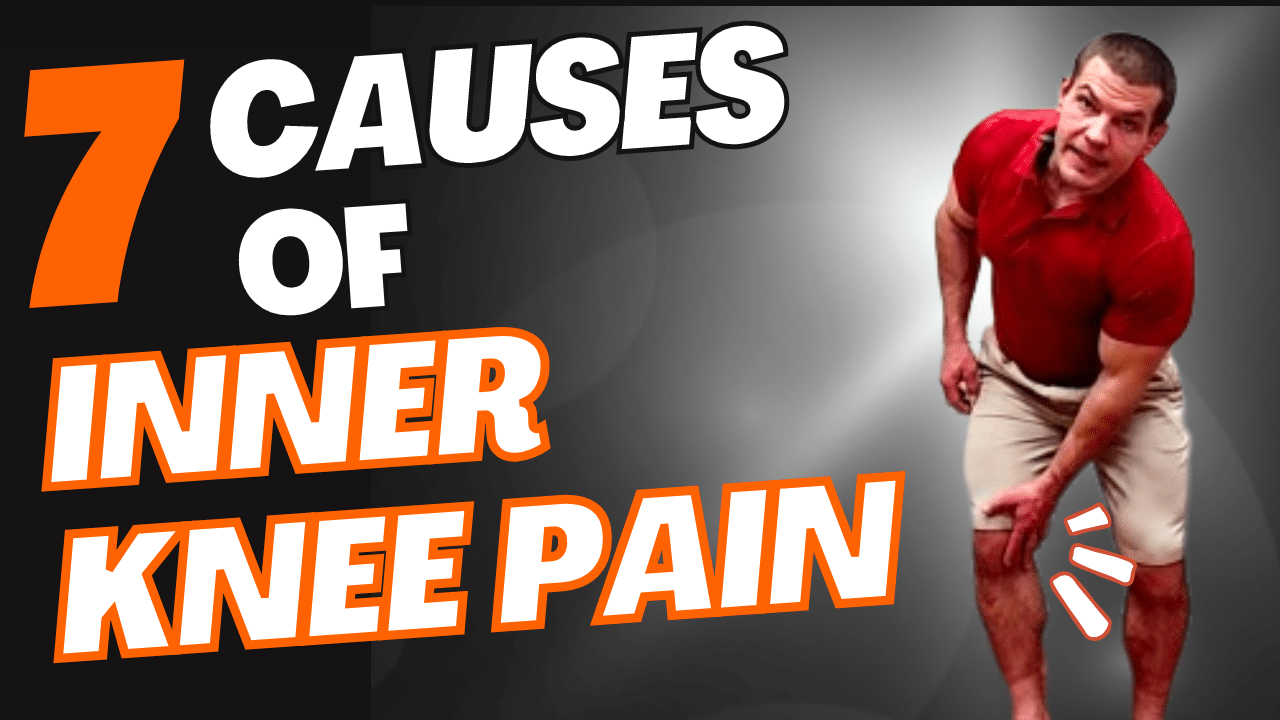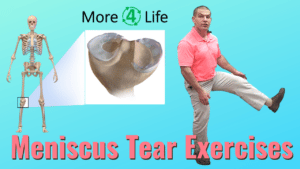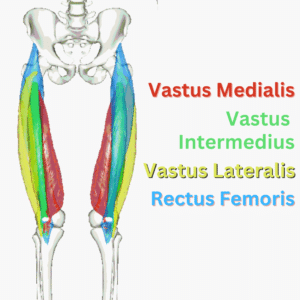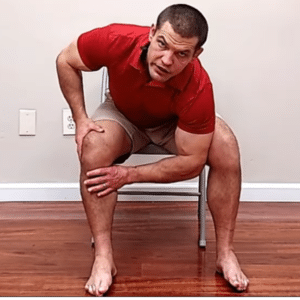Do You Get Inner Knee Pain Running, Walking, Or Going Up And Down Stairs?
Inner knee pain is incredibly common. In fact, I'd say is it's the most common area of knee pain that we hear patients complain about in our practice. But there are many different causes of inner knee pain.
Watch the video to learn 7 causes of inner knee pain plus 2 simple tips to fix pain on the inside of the knee
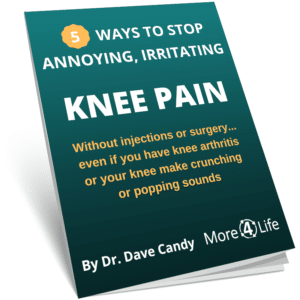
What Does Inner Knee Pain Mean?
In this post, I'll refer to inner knee pain as pain on the left side of the right knee, or pain on the right side of the left knee.
Some of these problems are inside the joint and some are outside of the joint.
However, by inner, I mean pain on the side of the knee closest to midline.
Or the medial term for that would be medial knee pain.
7 Causes Of Inner Knee Pain
I mentioned I would share seven different causes of inner knee pain. I'll start from inside the knee joint and then move outward.
Keep in mind though that although there are many different anatomical causes of inner knee pain, there are a few common causes that can create any one or more of the 7 of the problems.
Therefore, regardless of what type of inner knee pain you you have, many of the solutions will be similar.
And I'll share 2 very easy solutions to inner knee pain later in this post.
The 7 causes of inner knee pain are:
- Medial (inner) knee arthritis
- Medial meniscus tear
- Medial collateral ligament sprain
- Pes anserine tendinopathy / bursitis
- Vastus medialis (quadriceps) muscle pain
- Saphenous nerve dysfunction
- Referred pain from the lower back
Just understand that if you have pain on the inside of your knee, it may not be just one of these things. It may be a combination of a few different ones.
Fortunately, two simple tips can fix a lot of different types of inner knee pain, and sometimes rather quickly.
We'll go over those a little later in this post.
So first of all, let's start inside the joint...
What are the structures inside the knee joint that can cause inner knee pain?
Medial Knee Arthritis Pain
Inner knee pain can result from cartilage loss on the tibia, which is your lower leg bone, and the femur, which is your upper leg bone.
If you've worn down the cartilage between those two surfaces, you can get grinding of the bone on bone particularly if you've worn them down really, really far.
That can cause some inflammation and pain in the inside of your knee.
But not everyone who has knee arthritis has pain, even if the arthritis is really bad
So, there has to be something additional that causes one knee surface on the other in order to cause inflammation.
Often that is twisting of the knee.
Your knee is built in basically two separate compartments, an inner (medial) compartment, and an outer (lateral) compartment.
Your also have a front patellofemoral compartment between the kneecap (patella) and your thigh bone (femur).
Your knee joint is basically a hinge joint, so it MAINLY moves in a straight in a forward and back direction.
If that's happening, then your knee works pretty well, but if you end up getting too much twisting and side to side motion, that can create some grinding and twisting on the inside of your joint and cause some inflammation in the cartilage in your knee.
You've got the articular cartilage, which is irritated in osteoarthritis or rheumatoid arthritis.
(Note: Osteoarthritis is the normal kind of arthritis that occurs with aging. Rheumatoid arthritis is more of a systemic inflammatory arthritis.)
But there's another type of cartilage in your knee called fibrocartilage. You've probably heard of that type of cartilage referred to as the meniscus.
Medial Meniscus Pain
The meniscus is a fibrocartilage disc that sits on top of the actual cartilage.
The menisci forms a ring around the inner knee joint (medial meniscus) and the outer knee joint (lateral meniscus).
Together, they give the knee a little bit more stability.
But just like the articular cartilage, the menisci are susceptible to injury if you do a lot of twisting on your knee joint.
They can be injured by an athletic injury, for example, if you cut or pivot or twist too quickly.
But it can also be caused just by gradual wear and tear.
For example, if you're an overpronator and you do that for years and years and years on end, that can gradually wear down the meniscus over time.
Now the good news is that recent research has shown that most meniscus problems recover without surgery, and sometimes as good as, or better than, if you had surgery. That's true even if you have a meniscus tear on your MRI, it doesn't necessarily mean that you need surgery.
So those are the two causes of inner knee pain that are inside the knee joint: the meniscus and the articular cartilage.
Next moving to the ligaments on the inner knee...
Medial Collateral Ligament Sprain
The medial collateral ligament runs along the inside or medial side of your knee.
It is actually just a thickening of the joint capsule that sits around the knee.
Usually, if it's injured to a severe extent, it's from a traumatic injury such as getting hit from the outside of the knee in football.
You could also have a more mild irritation of that ligament from your knee joint getting out of position, which won't show on an MRI.
If you have done a lot of pronation, it can cause a little shift in your knee joint where the tibia will shift inwards on the femur.
This can cause problems with the medial collateral ligament, medial meniscus, or medial knee arthritis.
Grades of Medial Collateral Ligament Injuries:
- Grade 1 - Mild stretch of the ligament without tearing
- Grade 2 - Partial tear of the ligament
- Grade 3 - Full tear of the ligament
Usually Grade 1 injuries recover with the appropriate type of physical therapy. In fact, I show a manual therapy technique that you can do on yourself in the video at the top of this page.
Grade 2 injuries also recover pretty well with therapy and usually a knee brace to give your knee stability while the ligament is healing.
A grade 3 medial collateral ligament tear will require an extended period of bracing and therapy and may require surgery if you're hoping to get back to a high level of athletics that requires a lot cutting or side-to-side movement.
Moving outside of the knee joint itself, muscles and tendons around the knee can also cause inner knee pain.
One of the most common types of inner knee pain isn't in the knee joint itself.
It's just a little bit below on the inside where three tendons wrap around the inside of the knee and attach at what's called the pes anserine.
Pes Anserine Tendinopathy / Bursitis
The two pes anserine tendons that seem to be the most problematic are the gracilis, which is a hip adductor, and the semitendinosis, that is part of your inner hamstrings.
Those tendons attach on the inner side of the tibia and can cause inner knee pain just below the knee joint.
Once again, an inward twisting motion of your leg can cause an irritation of the pes anserine tendons.
We'll discuss how to stop that twisting motion after getting through the rest of the causes of inner knee pain.
Inner Knee Pain From The Vastus Medialis
Another muscular cause of inner knee pain is the vastus medialis, which is part of your quadrcieps muscles.
Vastus medialis pain is typically located on the inner knee just a little above the joint line.
Trigger points in that muscle or muscle knots in that muscle can cause pain on the inside of the knee.
Stretching your quadriceps is one great way to help with that type of problem. Physical therapy treatments like manual trigger point therapy or dry needling can also help.
So those are the musculotendinous causes of inner knee pain: pes anserine tendinopathy and vastus medialis pain.
Next on to nerve causes of inner knee pain...
A lot of people don't think about nerves as causes of inner knee pain.
They are less common than the more local structural things like the meniscus problems, arthritis, pes anserine tendinitis, and vastus medialis pain.
They do happen though, and they are things that you should consider if you're experiencing inner knee pain.
Inner Knee Pain From Saphenous Nerve Dysfunction
There's a nerve that runs along the inside of your knee called your saphenous nerve. It's a branch of your femoral nerve, as shown below.
Since the femoral nerve runs through your quadriceps, stretching your quadriceps can help relieve a saphenous nerve problem. Additionally, you want to avoid excessive twisting of your knee when walking or running, as that can also irritate the saphenous nerve.
Inner Knee Pain Referred Pain From the Lower Back
The final cause of inner knee pain that I'll cover actually isn't in your leg at all.
It's actually a pinched nerve in your lower back.
The L3 or The L4 nerves in your lower back refer pain down into the inner knee.
The L3 nerve (light blue) refers pain just down to the inner knee.
The L4 nerve (red dots) goes to the inner knee and then down into the lower leg as well.
To treat those causes of inner knee pain, I'd refer you to some of posts about sciatica and spinal stenosis.
Now, for the part of the post you probably really want to know...
How Do You Fix Inner Knee Pain?
I mentioned there are two really simple tips that can help a lot of different types of inner knee pain.
In many of the causes mentioned above, I mentioned an inward twisting type of motion of your leg.
This can come from over-pronating when you're walking, which may happen by your foot flattening out too much.
It may also happen if your hip muscles are too weak.
But when you get too much of that inward twisting motion of your leg, it has a lot of negative consequences on your knee:
- It over-stretches your medial collateral ligament.
- It puts stress on your pes anserine tendons.
- It causes twisting on your meniscus and articular cartilage inside of your knee joint
So that inward twisting motion of your probably the biggest individual cause of inner knee pain.
By avoiding that inward twisting or over-pronation, that's one really good way to stop a lot of different types of inner knee pain.
Now, how do you do that?
You've been walking for probably years by the time you're reading this, and so you've learned to walk in a specific way.
I'm guessing you don't have to think about the way that you walk. You probably just walk.
If your learned walking pattern happens to be twisting your knee inwards, how do you stop that?
One way is just to form a little arch in your foot by scrunching your toes a little bit and doming your arch.
When you do hit your foot on the ground when walking, hold your foot in a little bit of a dome, and try not to allow it to go completely flat as you put weight on it.
Additionally, you want to try to hit a little bit on the outer side of your foot.
Don't stay all the way on the outer side of your foot because that's not good for your foot.
But hitting a little more on the outer side of your foot WILL help you to avoid flattening out too quickly when you're walking.
Now that's a good way to prevent inner knee pain.
But what if you're already having inner knee pain?
If you've taken the time to read this far into this in this post, chances are that you may have some inner knee pain that you're trying to fix.
If you try walking as noted above and your knee still hurts, then what do you do?
A Quick Fix For Inner Knee Pain
Remember I mentioned a tibial shift earlier?
If your tibia (lower leg bone) has shifted out of position, then you want to correct that before you use the walking tip that I mentioned above.
In order to do that, you'll sit in the chair and put one hand and put it just below the knee joint on the inside of the tibia.
It helps to have your elbow bent and the inner thigh other leg up against your elbow. That will give you a little more pushing force when you go to do the knee joint treatment.
Next, take the other hand and put it on the outside of the thigh (femur) just above the knee joint.
Now push the tibia outward using your hand and your thigh while pushing the femur inward with your other hand.
This will re-align the knee joint if it has shifted out of position.
Hold about five to ten seconds, and repeat 5-10 times.
You shouldn't feel a whole lot of motion.
These are little tiny movements (about 1/8th of an inch), so you may not even feel like you're doing anything.
But hopefully, you will, when you stand back up, you'll feel that you've done something... because your knee won't hurt.
Conclusion
So, those are the 7 causes of inner knee pain, as well as 2 easy tips to relieve them.
If you need additional help to get rid of your knee pain faster, we'd be happy to help you.
Our specialists will take the time to help you figure out what's causing your knee pain as well as what you can do to fix it as fast as possible.
Tap the button below to request an appointment.
Here are some other posts about how to relieve knee pain that you might enjoy:
Do You Get Knee Pain At Night While Sleeping? Check Our our great post on "How To Relieve Back Pain, Hip Pain, & Knee Pain At Night While Sleeping"!
Do You Get Knee Pain When Squatting? Learn to Squat Without Knee Pain!
Do you get knee pain going up and down stairs? Check out the tips in our post "Prevent Knee Pain Going Up And Down Stairs"

